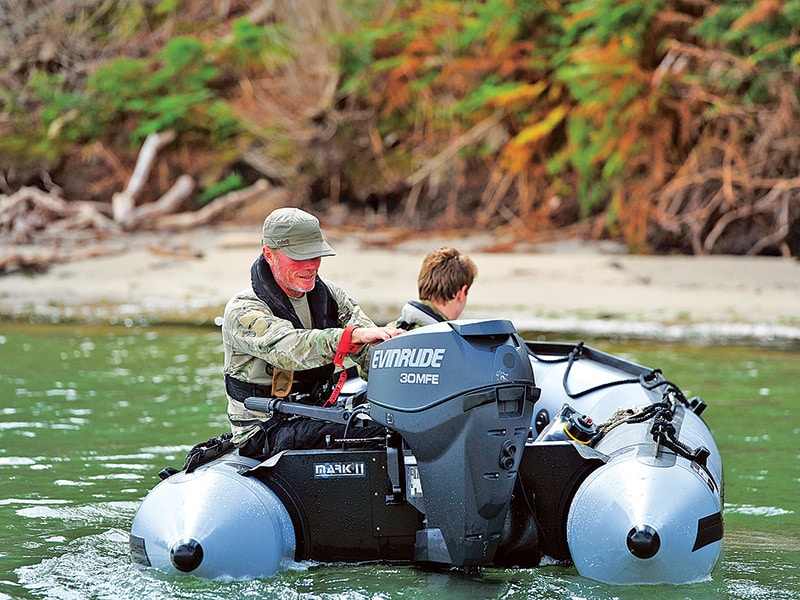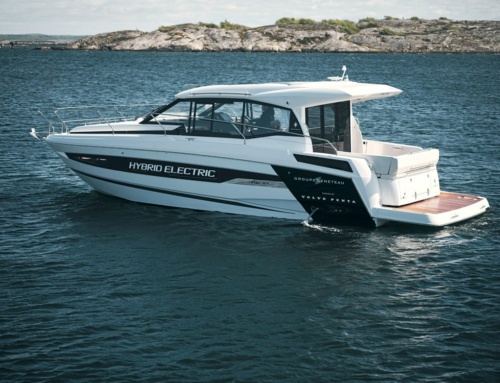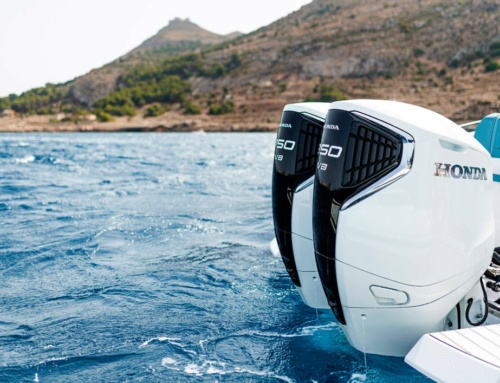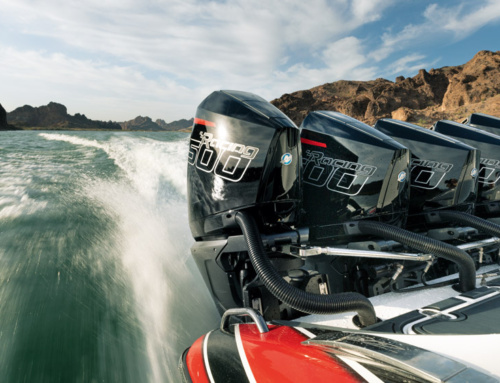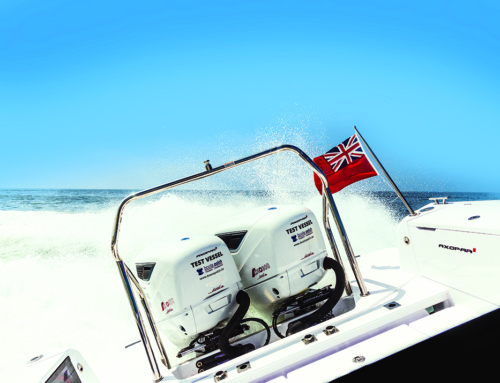- … the simplicity of switching between the two tanks meant I could repeat the change several times.
- Currently there is considerable interest in the research and development of the system from our waterborne services …
- The dangers associated with petrol are so much greater than diesel that implementing fire safety requirements is not cost-effective …
Evinrude 30 MPE
With the date for the move to single-fuel use across the military coming closer, Simon Everett takes up the tiller of Evinrude’s E-Tec with dual-fuel capability and gets a feel for the future.
The reason for this development in outboard engines that can run on heavy fuel is the ever greater restrictions being placed on the loose carriage of petrol. There is a need to get away from the complication of having to organise stowage of two fuel types, especially in commercial and military spheres of operation. In remote locations, and when working away from a fixed base, the advantage of having all your engines powered by the same fuel is pretty overwhelming, to say nothing of the reduced volatility of diesel fuel and the increased safety implications. There is already a directive for the MOD to be working to a single-fuel policy by 2019, so the race is on and the E-Tec is already over the starting line.
Even in leisure circles there are already great tracts of coast that are devoid of petrol refuelling facilities due to the cost involved in providing safe storage and delivery pumps. The dangers associated with petrol are so much greater than diesel that implementing fire safety requirements is not cost-effective, so from the Clyde right around the north coast of Scotland there are no petrol refuelling berths and special arrangements have to be made. In this kind of situation, having a diesel-powered outboard would be so much more convenient.
In the USA, the Evinrude E-Tec is the outboard engine of choice for military use, in the guise of a proven 55hp motor married either to a jet drive leg or to a conventional gearbox and propeller. This new 30hp outboard has been refined even further, with uprated electrics making it totally waterproof, and providing easier starting and cleaner running on diesel with less diesel knock and longer operating hours between services. One of the problems with ignition-fired diesel engines is that they coke up and require flushing at regular intervals. Extending these service intervals by making the motor run cleaner is where the development is being focused.
It isn’t just the military use that is driving the development of diesel-powered outboards either. The emergency services, commercial operations and large private yachts with paid crew also fall under the SOLAS regulations, which are demanding the same move away from the storage and use of petrol on board. Tenders will either have to be electrically propelled, run a diesel engine or resort to wind and manually powered alternatives. I don’t know about you, but I can’t see an oil sheik or Russian oligarch being rowed ashore myself, regardless of how elegant a means of propulsion it is. Outboard engine manufacturers are busy converting their existing petrol blocks to run on diesel, and the 2-stroke system is the simplest to convert without the finished engine gaining too much weight over its petrol counterpart.
The base engine for the E-Tec 30 MPE is the same solidly built motor that runs as a consumer 2-stroke outboard using high-pressure fuel-injected petrol. The fact that it is a 2-stroke simplifies the moving parts and helps to reduce weight – the 30 MPE only weighs a couple of kilos more than the current petrol version. As it stands, the 3-cylinder engine can run on either petrol or diesel at the mere flick of a switch. Under the tiller handle there is a green button – push it in to run on light fuel and pull it out to change the engine mapping for oil-fired running. It really is as simple as that. The same fuel line is used, it really is just the type of fuel that changes, so switching over is simplicity itself.
Currently there is considerable interest in the research and development of the system from our waterborne services, who are currently trialling the motor under their own operation requirements and the feedback has been positive. We got an exclusive day with the trials team and the engine on test to get a feel for what the future might hold. Make no mistake, the diesel outboard scenario has come of age, and this E-Tec MPE is in production and can be bought – if you have deep enough pockets.
We took the motor out of the back of a small Zodiac, which is the kind of craft it is being looked at for partnering. We had two tanks of fuel with us, one with petrol and the other with normal marine diesel from the Salterns fuelling berth. The fuel line would simply switch from one to the other using the quick coupling on the fuel tank and give us a direct comparison between one fuel and the other – on the same day, with the same boat and crew, in the same conditions. It isn’t scientific, but it is as real as we can get.
This was not a test of the boat and rig, it was a comparison between diesel fuelling and petrol fuelling of the same motor. I have to admit I was a little cautious at the start. I had visions of a smoky, lumpy transformation from the clean running of the petrol parameters to the diesel locomotion. My fears were soon dispelled, though, and the simplicity of switching between the two tanks meant I could repeat the change several times.
We needed something to use as a baseline so ran the engine on normal petrol first. In this guise, the MPE is just a standard 30hp E-Tec and behaved exactly as you would expect, with easy starting on half a pull, then running quietly and accelerating smoothly up to 20 knots. There might have been a bit more if we had pushed hard, but it was virtually at max. Then we tried the rate of acceleration a few times, and from standstill to 20 knots took 4.3 seconds running on petrol.
This was the bit I was waiting for – the switch over from petrol to diesel. Uncoupling the fuel line from the fuel tank, we ran her until she stopped, which didn’t take long. Because we were using the same fuel line there was a drop of residual petrol in the line to run through first, so we just did some general boating, nipping about literally just to burn fuel and get the diesel through the line so we were running on pure diesel. It was fairly obvious when the diesel was coming through as the engine note changed. At this point the mode button below the tiller arm was switched over from petrol to diesel; this was simply a matter of pulling the button out.
Now we were set for trialling on diesel. We still did a bit of messing about first, just to make sure. Then we spanked her up, and while there was an audible difference, the performance was virtually indistinguishable and the boat reached 20 knots perfectly happily. The engine note was a deeper grumble and slightly louder, and there was the merest hint of diesel knock, but being realistic it was no more than with petrol engines of 10 years ago. Giving the engine the acceleration test was where there was a measurable difference – from 4.3 seconds to 20 knots the engine now took 4.5 seconds, so a slight reduction in pickup, but not as much as the loss associated with going from petrol to LPG, for instance. The compression ratio of the petrol engine is not high enough to reach the required temperature for compression ignition, even though the injectors provide a fine enough mist, and spark ignition is maintained whether running on petrol or diesel. This is where further development needs to be carried out, because diesel fuel does create limitations in the hours that can be run before the engine needs to be cleaned. While petrol is available, this is simply a matter of flushing it through by running on petrol, but that negates the entire reason for having diesel fuel only. It is this aspect of the engine that requires perfecting, but the ability to run on petrol, spirit (they have demonstrated it running on whisky!) or AV1, kerosene and diesel is mighty impressive. Add in the ability to self-purge if submerged and rope-start it on two or three pulls and the innovation becomes clear.
So who might be in the market for these expensive outboards? Certainly the main focus is on military and rescue service use, but remote locations where diesel is the only practical fuel available would also be a market. While we were out testing, Salterns, who are the main UK dealer for these specialist outboards, sold two to a film production company who needed them for a film they are actually in the process of making.
Performance
- Acceleration on petrol: 0–20 knots 4.3 seconds
- Acceleration on diesel: 0–20 knots 4.5 seconds
Specifications
- Engine type: Inline 2-cylinder 2-stroke
- Displacement: 575cc
- Bore & stroke: 76.0mm x 63.5mm
- Operating RPM: 5500–6000
- Propshaft power: 30hp @ 5800rpm
- Weight: 160lb
- Shaft: 20″
- Gear ratio: 2.15:1
- Starter: Recoil manual start
- Tilt mechanism: Manual
- Steering: Tiller handle
- Lubrication: Pump, on-board oil tank
- Ignition: Spark ignited
- Crank case drain: 2 valve drains in lower crank case for submersion venting
Contact
Engine and inflatable kindly supplied by:
Golden Arrow Marine
27 West Quay Road
Poole
Dorset BH15 1HX
Telephone: 01202 677387

